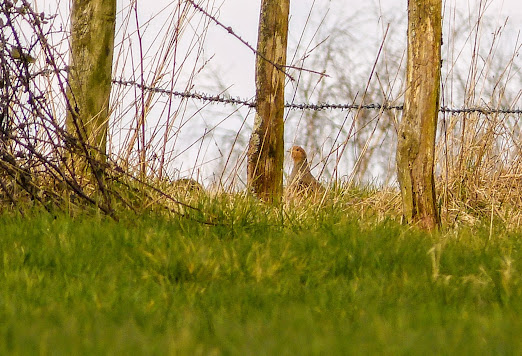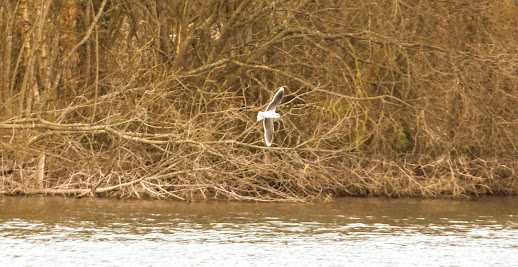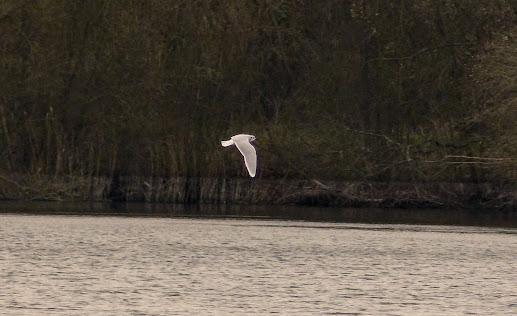Saturday 9th March 2024.
It was back to birding with my good pals Geoff Farwell and Andy Fisher today and we had a cracking day birding around some of the best areas of Hampshire and notch up three more Hampshire ‘year-ticks’ on our travels. We went to five locations in all; kicking off with Implacable Road in Lee-on-Solent for a possible Black Redstart, then off to the countryside in North Baddesley for Grey Partridge, then off to Blashford Lakes for possible Sand Martin and Little Ringed Plover, then Testwood Lakes for a Little Gull and finally rounding off a superb day at the tiny hamlet of Coombe, near Old Winchester Hill for Little Owl. Phew. Though we were not successful with all the areas, there were some nice sightings around. The weather was a bit indifferent, with a cold blustery easterly wind blowing all day, but it mostly remained dry all day, barring a few spots of rain around the Blashford area.
The day kicked off with the moths. Andy had his moth box on overnight and we scored this time with four moths that included two that were new for the year: Hebrew Character and the micro moth, Diurnea fagella (also known as the March Dagger moth). There was also one Common Plume and one Light Brown Apple Moth found close to the box itself and was nearly overlooked. You really need a sharp eye sometimes for the smaller moths! What a good start to the day and it was only to get better.
Implacable Road, Lee on Solent:
There had been reports of both a female and a male Black Redstart at this site over the past few weeks and after seeing the superb photos of various birders on Facebook (including Emma Parkes and Rob Porter), I was hoping the birds would still be here. We strolled around the road, looking at all the possible sites the birds could be lurking about, including Archers Drive and Daedalus Drive, but to no avail and so we back-tracked on ourselves and returned to walk along Implacable Road again. From here, we had sightings of a Med Gull flying over and several Linnets and Goldfinches going over. A poor dog Fox, with a bad case of mange, was seen (see photos) by the old factories, but moved on as we continued to search for the Black Redstart. We started to walk back to where the car was parked and then I saw a male Black Redstart fly over the road and land in a compound; but it quickly flew on the ground and out of sight. Thankfully, it popped out again and landed on a small brick wall. But that was the longest it settled for and quickly flew off and out of sight behind the buildings. Happy with our first Black Redstart of the year, we then made tracks for our next quest - the Grey Partridge.
North Baddesley:
Birding pals, Emma and Matt Parkes were already at the sight where the Grey Partridge were and Emma had taken some excellent photos of the birds. I had already seen Grey Partridge this year up in Norfolk, but I still needed to see my first Hampshire birds (which is not an easy bird to connect with) and on arrival within the countryside at Nutburn Road, we parked up on the lay-by and took special care with the passing traffic going past. Lesser Celandine plants were in flower along the roadside, adding a splash of colour among all the green leaves present. One had to climb a steep bank to view the birds and so I gingerly made my way up to view the fields and all that was present was two white farmyard Geese and a pair of Canada Geese in the fields! Boo! The guys had tried their luck on the opposite side of the road and though there was a Red-legged Partridge and a small herd of Roe Deer, there was no sign of any Grey Partridge. I gave Emma a quick call and she gave me directions on where to view the birds and before long, we had our first Hampshire Grey Partridges under our belt! At least three Grey Partridge were tucked up low by the fence posts segregating the two fields, but they were distant. So we moved further up the road, climbed the steep bank yet again and this time got reasonable views of at least one of the birds. A Red-legged Partridge was also present with them, but moved off into the field. Happy days. Two more Hampshire ‘year-ticks’ and it was only 10.30am. Next stop, Blashford Lakes.
Blashford Lakes:
Realising that the Tern Hide was going to be packed (judging by all the birders' cars present), we decided to do our birding from the Viewpoint overlooking the Tern Hide and Ibsley Water and spent the next couple of hours here. Most of the wildfowl were in front of the Goosander Hide, which was probably due to the horrible easterly wind blowing across the water. Sadly, no migrants were seen, but there was plenty to look at during our time there including good numbers of Red Kite flying over and occasionally, Marsh Harriers and Common Buzzards. The wildfowl mostly were Pintail and Shoveler, with smaller numbers of Tufted Duck, Mallard and around 5 Goldeneye, including two drakes. While scouring the Lake through my scope, I saw a Kingfisher briefly fly across the lake and at least 8 Pied Wagtails were on the spit in front of the Tern Hide. Checking Birdguides on my mobile phone, the Little Gull had been seen again on Testwood Lakes and so, our next destination was set in stone.
Testwood Lakes:
The Little Gull, an adult winter bird, was still present on the smaller of the two lakes, Little Testwood Lake and after parking in the car park (first time Geoff has ever been here, apparently), we made our way hastily to the said lake and before long, Geoff and I were watching our first Little Gull of the year. Andy had seen one earlier this year off Sandy Point, but I quickly got into photographic mode, though the bird remained mostly over the other side of the lake. It was very active, picking off small flies off the water or just over the water as it flew back and forth up and down the small lake, showing off its attractive darker underwing. It was virtually the only bird here, though we did see a pair of Great Crested Grebes and a drake Tufted Duck just before we left.
Coombe:
Our final stop was to be the tiny hamlet of Coombe, which is not far from Old Winchester Hill. An area of lovely farmland, surrounded by steep hills, barns and very few houses, it was an idyllic setting. Me and the guys had been here before in search of the Little Owls and like today, the birds were not on view again. We even stayed up to 5pm, hoping for a glimpse of these lovely birds, but to no avail, but we did have a nice list of birds and mammals to look at during the couple of hours we spent there. Getting out of the car, after carefully parking on the roadside, we were greeted by a singing Firecrest deep within some Ivy clad trees, but we never got a sighting of the bird. We hastily headed further up the road to view the Barns to the south and even got a glimpse of a Barn Owl flying into one of the Barns. Both Red Kites and Common Buzzards hunting over the countryside here (Geoff saw 32 Common Buzzards here recently and also the two Little Owls bathing in the sunshine!). A male Kestrel perched on one of the Gables and several Ravens flew over. Out in the fields, there was a huge number of Fieldfares feeding with roughly equal numbers of Starlings; approximately 200+ of each, which was easily the highest number I have seen here. To continue with the raptor sightings, a female Sparrowhawk sped across the field towards the Barns with prey in its talons, hotly pursued by a Crow. Skylarks were seen distantly over the hills to the south and a Red-legged Partridge was seen in a field nearby. Mentioning mammals earlier, several Hares were seen out in the fields and showed well through the scope. It was now turning rather cold at 5pm and so we made our way home, happy with another superb day's birding.





















No comments:
Post a Comment